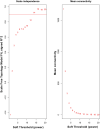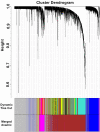Weighted gene co-expression network analysis identifies specific modules and hub genes related to coronary artery disease
- PMID: 33758323
- PMCID: PMC7988178
- DOI: 10.1038/s41598-021-86207-0
Weighted gene co-expression network analysis identifies specific modules and hub genes related to coronary artery disease
Abstract
This investigation seeks to dissect coronary artery disease molecular target candidates along with its underlying molecular mechanisms. Data on patients with CAD across three separate array data sets, GSE66360, GSE19339 and GSE97320 were extracted. The gene expression profiles were obtained by normalizing and removing the differences between the three data sets, and important modules linked to coronary heart disease were identified using weighted gene co-expression network analysis (WGCNA). Gene Ontology (GO) functional and Kyoto Encyclopedia of Genes and genomes (KEGG) pathway enrichment analyses were applied in order to identify statistically significant genetic modules with the Database for Annotation, Visualization and Integrated Discovery (DAVID) online tool (version 6.8; http://david.abcc.ncifcrf.gov ). The online STRING tool was used to construct a protein-protein interaction (PPI) network, followed by the use of Molecular Complex Detection (MCODE) plug-ins in Cytoscape software to identify hub genes. Two significant modules (green-yellow and magenta) were identified in the CAD samples. Genes in the magenta module were noted to be involved in inflammatory and immune-related pathways, based on GO and KEGG enrichment analyses. After the MCODE analysis, two different MCODE complexes were identified in the magenta module, and four hub genes (ITGAM, degree = 39; CAMP, degree = 37; TYROBP, degree = 28; ICAM1, degree = 18) were uncovered to be critical players in mediating CAD. Independent verification data as well as our RT-qPCR results were highly consistent with the above finding. ITGAM, CAMP, TYROBP and ICAM1 are potential targets in CAD. The underlying mechanism may be related to the transendothelial migration of leukocytes and the immune response.
Conflict of interest statement
The authors declare no competing interests.
Figures








References
-
- Roffi M, et al. 2015 ESC Guidelines for the management of acute coronary syndromes in patients presenting without persistent ST-segment elevation: Task Force for the Management of Acute Coronary Syndromes in Patients Presenting without Persistent ST-Segment Elevation of the European Society of Cardiology (ESC) Eur. Heart J. 2016;37:267–315. doi: 10.1093/eurheartj/ehv320. - DOI - PubMed
Publication types
MeSH terms
Substances
LinkOut - more resources
Full Text Sources
Other Literature Sources
Medical
Research Materials
Miscellaneous

